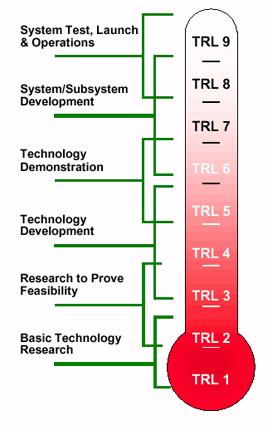In our last post we discussed Technology Readiness Levels (TRLs) and how they may be used by entrepreneurs, established companies, investors and other stakeholders. In this post we will look at some interesting ideas on TRLs for intellectual property.
TRLs can be used to help entrepreneurs understand the risk of new inventions. TRLs demonstrate how even very promising technologies may suffer from critical failures as they mature. Very few pioneering technologies behave completely as expected in all circumstances and unforeseen technical failure is to be expected in a large number of cases. Seeing the various levels and the progression of steps through which a technology must travel helps many entrepreneurs appreciate the risks and hurdles that must be overcome.
This is one reason why it is important to diversify technology as well as intellectual property protection. Innovators should pursue alternative technical approaches to a problem and each approach should be protected with separate patent applications. If a favored technology does not work out, then one of the alternative approaches should work and there will be a patent to protect it.
TRLs can also be used to demonstrate the timing of patent applications. While merely experimenting with an invention in a laboratory will not normally bar patentability, using the invention in public or using the invention in a commercial context can certainly create a bar. Therefore, patent applications should be filed while a technology has a low TRL.
While it is usually best to file first and ask questions later, patent applications filed too early may not be patentable. For example, merely identifying a problem to be solved or identifying some natural principal, as in NASA’s level 1 above, would not constitute a patentable invention. A specific workable solution to the problem must be conceived for there to be a patentable invention. Therefore, NASA’s level 2 is probably where most inventions begin to be patentable. In some cases experimental data may be needed from higher levels to prepare a patent application.
As a technology progresses through each level, the technology should be evaluated to determine if any new intellectual property has been developed. Often new inventions are conceived as a technology matures to deal with unforeseen problems. Sometimes these secondary inventions are more valuable than the primary invention.
For patent attorneys, TRLs may be used to argue for non-obviousness; a key test for patentability. If an invention is in a technical field that has a low TRL, then an invention is less likely to be obvious because there is little knowledge in the field. Technical fields with low TRLs have little accumulated knowledge. There is little basis for someone of ordinary skill in the art to expect that an invention will achieve a certain result. Therefore, the scope of what is an expected result is narrower and more things are non-obvious.
For example, the field of 3D printers is relatively new and this field has a low TRL when compared to more mature technologies, such as steam engines. An invention in 3D printers is arguably less likely to be obvious because the amount of knowledge is small and fewer things have been tried. Of course, patentability depends on the particular invention and the prior art. Merely having a low TRL will not overcome every obviousness rejection.


